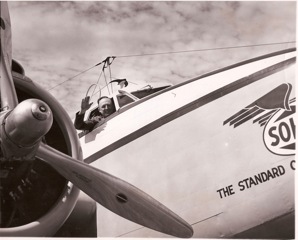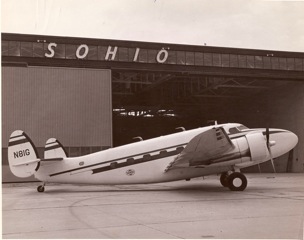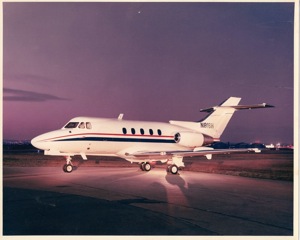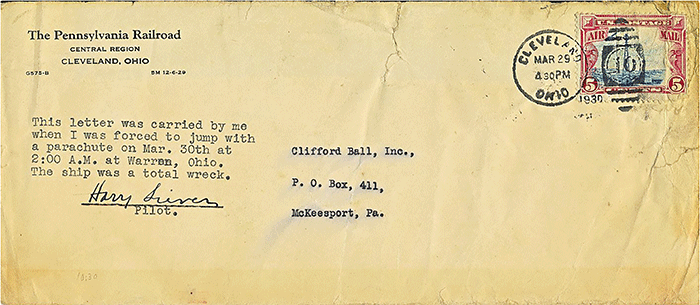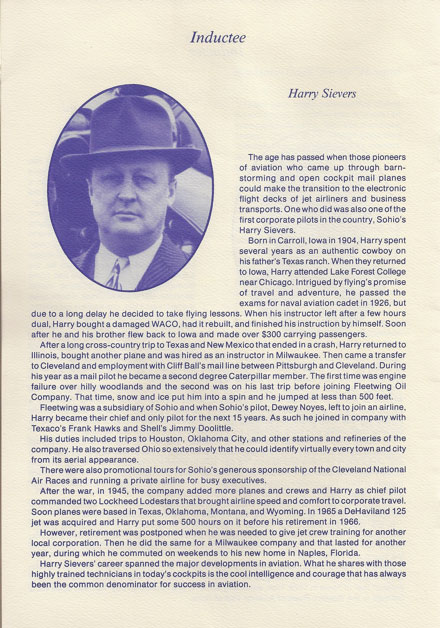THANK YOU!
YOUR PURCHASE OF THESE BOOKS SUPPORTS THE WEB SITES THAT BRING TO YOU THE HISTORY BEHIND OLD AIRFIELD REGISTERS
Your copy of the Davis-Monthan Airfield Register 1925-1936 with all the pilots' signatures and helpful cross-references to pilots and their aircraft is available at the link. 375 pages with black & white photographs and extensive tables
---o0o---
The Congress of Ghosts (available as eBook) is an anniversary celebration for 2010. It is an historical biography, that celebrates the 5th year online of www.dmairfield.org and the 10th year of effort on the project dedicated to analyze and exhibit the history embodied in the Register of the Davis-Monthan Airfield, Tucson, AZ. This book includes over thirty people, aircraft and events that swirled through Tucson between 1925 and 1936. It includes across 277 pages previously unpublished photographs and texts, and facsimiles of personal letters, diaries and military orders. Order your copy at the link.
---o0o---
Military Aircraft of the Davis Monthan Register 1925-1936 is available at the link. This book describes and illustrates with black & white photographs the majority of military aircraft that landed at the Davis-Monthan Airfield between 1925 and 1936. The book includes biographies of some of the pilots who flew the aircraft to Tucson as well as extensive listings of all the pilots and airplanes. Use this FORM to order a copy signed by the author, while supplies last.
---o0o---
Art Goebel's Own Story by Art Goebel (edited by G.W. Hyatt) is written in language that expands for us his life as a Golden Age aviation entrepreneur, who used his aviation exploits to build a business around his passion. Available as a free download at the link.
---o0o---
Winners' Viewpoints: The Great 1927 Trans-Pacific Dole Race (available as eBook) is available at the link. This book describes and illustrates with black & white photographs the majority of military aircraft that landed at the Davis-Monthan Airfield between 1925 and 1936. The book includes biographies of some of the pilots who flew the aircraft to Tucson as well as extensive listings of all the pilots and airplanes. Use this FORM to order a copy signed by the author, while supplies last.
---o0o---
Clover Field: The first Century of Aviation in the Golden State (available in paperback) With the 100th anniversary in 2017 of the use of Clover Field as a place to land aircraft in Santa Monica, this book celebrates that use by exploring some of the people and aircraft that made the airport great. 281 pages, black & white photographs.
---o0o---
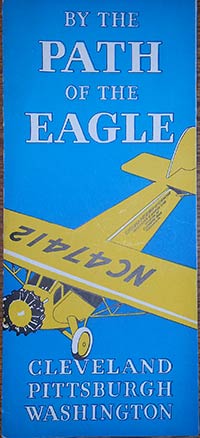 |
YOU CAN HELP
I'm looking for information and photographs of pilot Ball to include on this page. If you have some you'd like to share, please click this FORM to contact me.
---o0o---
SPONSORED LINKS
HELP KEEP THESE WEB SITES ONLINE
FOR YOUR CONVENIENCE
You may NOW donate via PAYPAL by clicking the "Donate" icon below and using your credit card. You may use your card or your PAYPAL account. You are not required to have a PAYPAL account to donate.
When your donation clears the PAYPAL system, a certified receipt from Delta Mike Airfield, Inc. will be emailed to you for your tax purposes.
---o0o---
CLIFFORD BALL
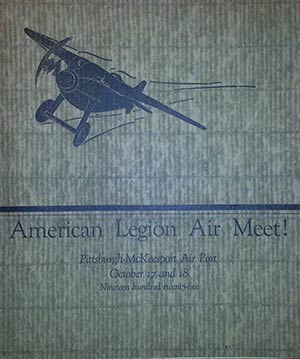 |
Much of this information is summarized from the Papers of Clifford Ball, 1926-1976, MSS #12, Historical Society of Western Pennsylvania, available at the Heinz History Center (HHC), Pittsburgh, PA. Many thanks to Matt Strauss, Chief Archivist, for his kind guidance in helping me review these Papers and other items in the Center's collections. The Ball Papers include correspondence, news clippings, printed materials, speeches and other items related to the early air transport and air mail industries in Pennsylvania.
Clifford Ball landed at Pitcairn Field once, ca. May 12, 1928 (the exact date was not specified). He was a passenger with air mail pilot, Dewey L. Noyes (see below). Noyes was the husband of Register pilot Blanche Wilcox Noyes who later touched down at Willow Grove on May 7, 1930.
Clifford Ball's interest in aviation began when he paid $15 for his first flight in the obligatory Jenny, date unknown. By 1924, he was a real believer in the future of aviation. He mortgaged his property to raise $35,000 and purchased forty acres of land in West Miflin, PA where he built an airport. The airport became Bettis Field, named after Cyrus Bettis, a WWI ace. Bettis Field was first used for air shows and flying lessons. The American Legion Air Meet was held at Bettis Field during October, 1925. A full copy of the program for the Meet is included in Ball's Papers. The cover of the brochure is exhibited at right, and the full text is available as a PDF (3Mb) at the link.
Ball soon turned his attention to forming a commercial enterprise for his two aircraft and airfield. In 1927 (April?), he won the government contract (Contract Air Mail route #11)to run the first air mail line from Pittsburgh, PA to Cleveland, OH. Within a year, he began the first night air mail service.
Among Ball's Papers is a crude, but very significant, record of air mail traffic through Bettis Field. This exciting artifact is a standard stenographer's notebook that documented, by hand, Ball's early air mail operations. Below is a page from the book that summarizes trips made during 1927. I enhanced the notebook images in PhotoShop for better readability.
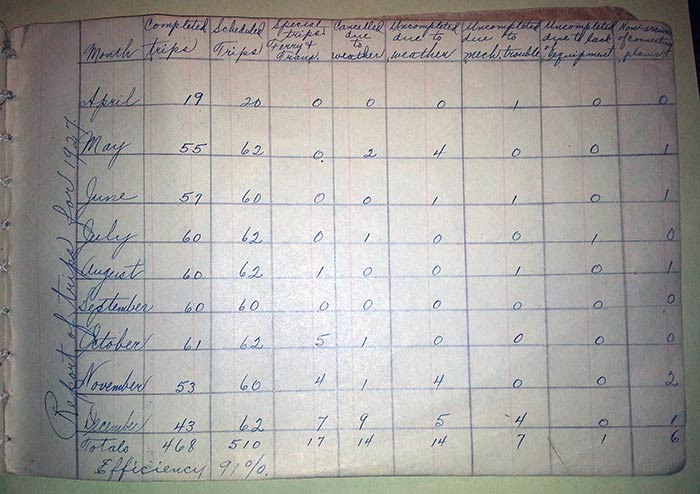 |
Averaging near two trips per day over nine months, Ball's air mail operation logged an efficiency of 91%. Incomplete trips were due more to weather than to mechanical or any other problems. Below is logged the number of pounds and ounces of mail carried for the same period.
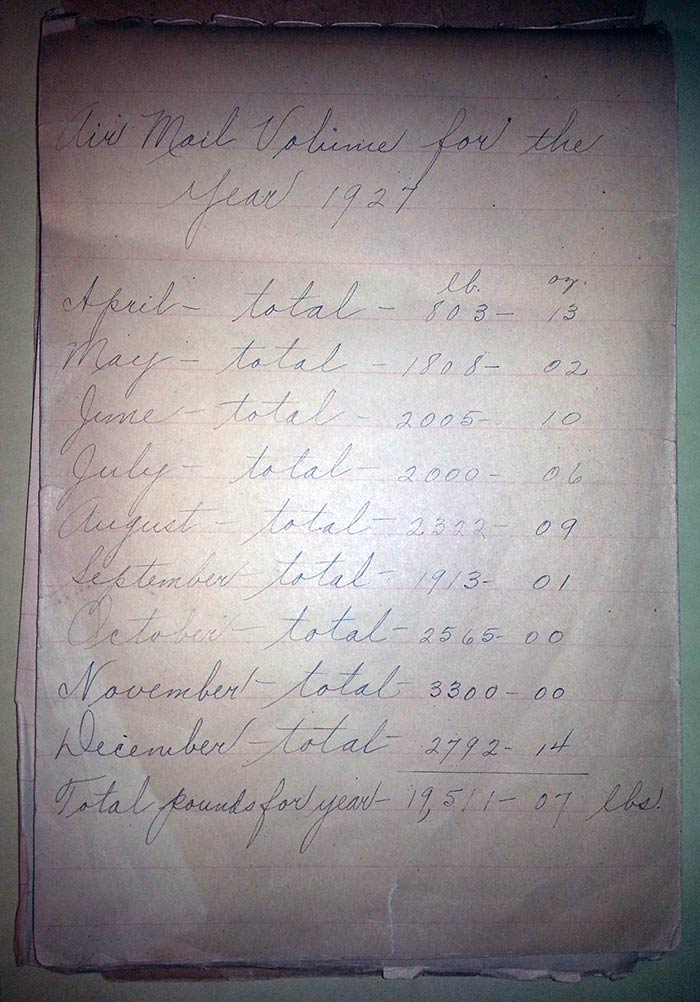 |
According to the data, 19,511 pounds of mail were carried over 468 completed flights in 1927. This averages about 42 pounds of mail per flight. Similar records by month for 1928 and 1929, which include notations of individual flights by individual pilots, are in the steno notebook. The pilots who carried the air mail for Ball are cited by name. They are: R.L. Baker, Clarence Bell, Edmund Henriques, Horace Stark, Harry Sievers*, E. Couples, Harry Sebree, Dewey L. Noyes, Kenneth "Curley" F. Lovejoy, Eugene Cecil, Al Litzenberger (see photo below), J.Warren Smith, William A. "Billy" Hughes, C.V. Pickup (Davis-Monthan Register pilot), H.H. Tallman, E.D. Woodgerd and S.V. Kramer. I list them here so that search engines will pick them up. If you know about any of them, please let me KNOW. The complete 1927-1929 air mail record in the steno notebook is available at the link (PDF 20Mb, 22 pages).
Below is a photograph from the Library of Congress (LOC) showing an airmail plane operated by Ball. The pilot is identified by a site visitor as Alvene Litzenberger. The location was identified as Bolling Field, Washington, DC, 1920, but that was a little too far east for Ball's territory, and about a decade too early for his business. Regardless the date/location discrepancy, from the wing strut and windshield geometry, this is probably one of the models of Pitcairn mail plane. Note the marvelously muddy mess on the wing and lower fuselage, indicative of the unimproved fields that serviced this airplane.
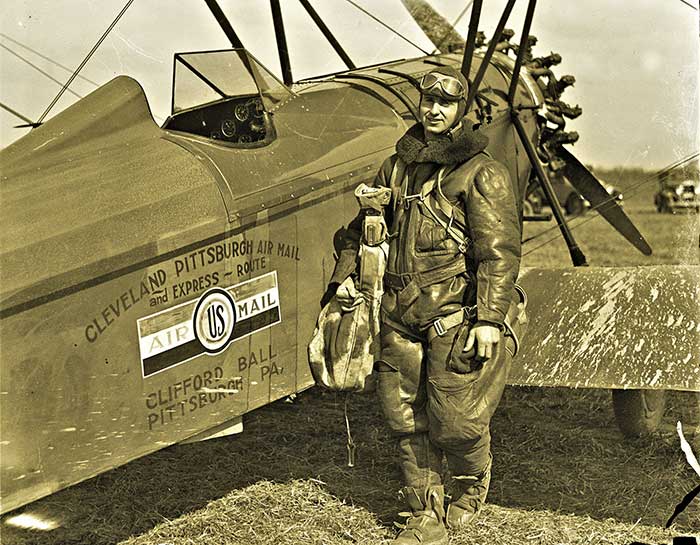 |
The pilot's suit appears to be the Spalding Model W-270, Codovan Leather Shell winter flying suit. It had a "Beaverized sheep lining" and "electrified lamb collar." It cost $100 new. His shoes appear to be the Spalding Model 200 Army Aviators' Overshoe. It was a, "Moccasin style, made up of the best quality of leather. Fleece-lined. Three strap fasteners. Seamless sole extends up back of heel." Cost $15.
But I digress. As well as his air mail contract, in 1929, Ball initiated a day passenger route from Cleveland, OH to Washington, DC called the "Path of Eagles." His airline was known as the Pennsylvania Air Lines and operated as part of the Clifford Ball System (air mail, passenger transport, flight training). Below, a pristine four-fold, color brochure that advertised his airline and fares. The first image illustrates Pittsburgh's location within Ball's airline route.
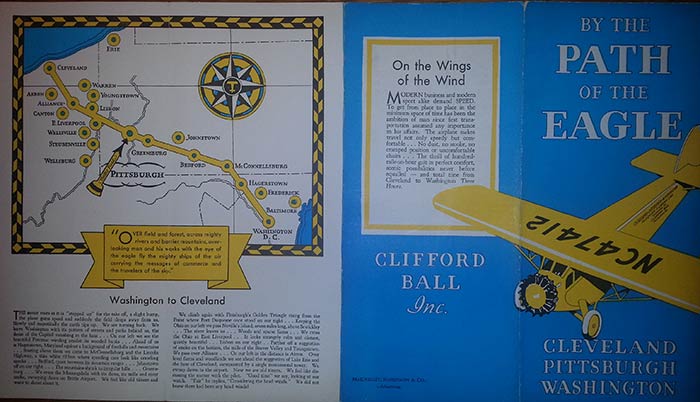 |
The second image, below, shows the inside of the brochure. It orients "beginners," describes the qualifications of line pilots and Clifford Ball, Inc., and provides a list of fares ($45 for Cleveland to Washington)..
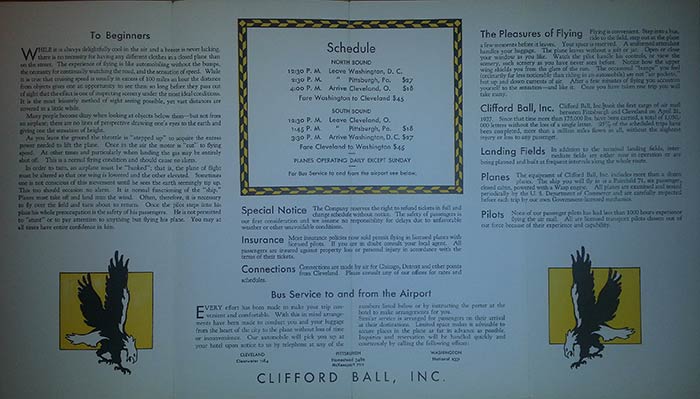 |
Below, right, a 2/3-page advertisement Ball took out in the November, 1930 issue of Popular Aviation (PA) magazine. Notice the difference in air fares compared to the brochure above. The price came down, probably in response to the deepening Great Depression.
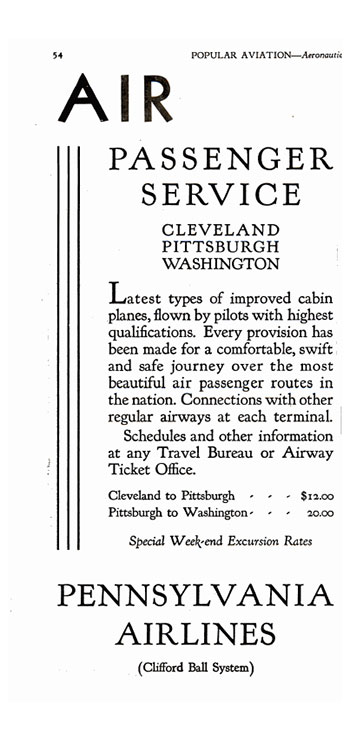 |
In 1930, Ball sold his business abruptly because of political and financial pressures related to the possible loss of his airmail contract. His business sold for $130,000, a net gain of about $100,000 over three years. His "Path of the Eagle" continued, and eventually merged to become part of Capital and then United Airlines. Popular Aviation magazine, January, 1940, featured Clifford Ball and his "Path of the Eagle." You may download the article at the link (PDF 2Mb). The article traces the history from his airmail activities to the formation and operation of Pennsylvania Central Airlines. You'll find a couple of discrepancies between numbers of personnel and weights and measures (e.g. 19,511 pounds of mail vs. 19,573), close but not exact.
 |
Ball continued his work in aviation for the rest of his life. During WWII, he served as a captain in the Civil Air Patrol. As such, he was managing director for Graham Aviation Company's operations at the Butler, Clarion, Oil City and Meadville airports where, during the war, 1,400 instructors and 7,000 pilots were trained for the Army.
In 1952, he took the job as the first superintendent of the Greater Pittsburgh International Airport, and, later, as director of the Allegheny County Airport in Pittsburgh. In 1965, he was honored by the Pittsburgh Institute of Aeronautics by the naming of their new facility the Clifford Ball Academic Building. In 1955, ever the organizer, Ball was among the nine founders of the OX-5 Aviation Club. He served as national secretary of the organization.
Clifford Ball was born in Banksville, PA (now part of Pittsburgh) on November 29, 1891. He was the tenth of eleven children. He attended public school in Dravosburg, PA, and graduated from McKeesport, PA high school in 1910. After high school, he took finance courses at Duquesne University and Duff's Iron City College and worked as a clerk at the Federal National Bank.
During WWI, he served in the U.S. Army and fought at Chateau Thiery and in the Argone Forest. After the war, he started an automobile business with $5,000 he had saved. On February 12, 1929, he married a former air racing pilot, Helen Stinner. Her pilot log book is among Ball's Papers, as is a bill of sale for a Monocoupe aircraft, NC429N (not signed into any Register), purchased by Helen Ball on August 16, 1932. The Balls had one daughter, and lived in Mr. Lebanon, PA for many years. Despite Ball's life-long interest and participation in aviation, he never learned to fly. Ball passed away on Friday, June 2, 1972 at the headquarters of the OX-5 Aviation Club. Helen Stinner Ball passed away August 24, 1993 at age 90. His Bettis Field is now the site of Bettis Atomic Power Laboratories, a division of Westinghouse Electric Corporation. No trace of the airfield remains today.
In 2016, a road was named "Clifford Ball Drive" at the Pittsburgh International Airport. The dedication (YouTube) is at the link.
---o0o---
*UPDATE OF 03/17/14 As happens sometimes, relatives of people cited on these pages contact me with information about their kin. This example concerns Harry Sievers, mentioned above as one of the pilots who carried the air mail for Clifford Ball. Sievers' son, Trevor, shares with us the following information about his father. It is a biographical sketch written by Harry Sievers, ca. 1990. Not only does the text describe his aviation life, it is illustrated with a dozen photographs, and it includes at the end a tabulation of all the presidents, pilots and aircraft flown by the Standard Oil Company of Ohio, Sohio. Sievers is further featured at the link in the September, 1935 issue of The Sohioan, the internal magazine of the Standard Oil Company.
Aviation Adventures of Harry Sievers My interest in aviation began in 1925 while attending Lake Forest College near Chicago, Illinois. My first airplane ride was with a barnstormer in an Old Standard biplane in Wheeling, Illinois, 30 miles northwest of Chicago, at a cost of $30.00 an hour. While in school, a friend of mine and I applied to the Great Lakes Naval Training Center to become Navy pilots. When we completed our exams, there were no airplanes to fly. While waiting for the Navy to get a few airplanes, my boss told me "You're wasting too much time away from work, either you join the Navy or get back to work". I gave up flying for the Navy and went back to work. [The New Standard aircraft posed with the mail truck was an airplane Sievers flew for Clifford Ball's airmail route.]
In the fall of 1928, I was offered a job as a flight instructor in Pontiac, Michigan. After being there two or three months, I moved to Cleveland, Ohio as a flight instructor. On March 1, 1929, I got a job flying the air mail from Cleveland to Pittsburgh and back with Clifford Ball. Clifford Ball won the first government contract to fly the air mail from Bettis Airport in Pittsburgh, Pennsylvania to Hopkins Airport in Cleveland, Ohio in April 27, 1927. [see the link to the steno notebook record of air mail flights linked above] During this time, I taught myself how to fly blind which helped me through many winter snowfalls. We later experimented picking up the mail without landing. October 21, 1929, I was flying from Pittsburgh to Cleveland when my motor quit due to a plugged up carburetor over Beaver Falls, Pennsylvania and had to jump-out. The second time I had to jump was March 30, 1930 over Warren, Ohio. Again at night, heavy snow and ice plugged up my venturi [a device that supplied vacuum to attitude instruments in the cockpit] on the side of the cockpit which eliminated the only instruments I had. My only way out was to turn back. Flying blind, I notice the airplane was descending due to ice on the wing, so I decided to jump. [Below is an envelope carried by Siever, annotated to verify it was carried in his airplane that night.]
This happened to be my last flight with Clifford Ball before going to work for the Standard Oil Company of Ohio in Cleveland the next day. Having heard about me wrecking another airmail plane, they were concerned about hiring me to be their pilot. Management decided it would be a good idea if I would take the company plane, a Ryan B-5 (NC9238), for a few weeks to show that I could handle it. Since I was getting married April 19, 1930 to Mabel Anderson in Erie, Pennsylvania, I took the company plane on my honeymoon to Carroll, Iowa. Mabel, my new wife, and I made it back to Cleveland and everything went smoothly. It was a good airplane in which I carried many passengers for work. This went on for a year, when during the depression, Sohio sold the Ryan B-5 to a car dealer in Hot Springs, Arkansas on November 10, 1931. With no airplane, I worked at Sohio's number two refinery in Cleveland for about three months. Then Sohio decided to buy a Stinson (NC412M) [this airplane was identified as a Fleet in the Grand Central Air Terminal Register; probably an identification error by the Grand Central tower operator who noted it in the Register]. Dewey Noyes, Sohio's chief pilot, decided to leave and work elsewhere. This made me Sohio's only pilot for many years to come. The Stinson later sold to Fawset Air Lines in Lima, Peru. I flew it for about a year when Sohio decided to buy a Waco (NC12464) that was manufactured May 28,1932. This plane was cracked up August 30, 1933 and was returned to the factory to be rebuilt. Sohio bought another Waco (NC13425) that was manufactured July 6, 1933. Sohio bought a custom cabin Waco (NC14623) with a Wright powered engine that was manufactured June 13, 1935. I had accumulated over 400 hours when Waco decided to ground all of their airplanes since four of them had crashed due to wing failures. It just so happened the pilots in Findley, Ohio were observing a Waco land and saw the wing separate, so they were able to locate the problem. The only reason that we did not have a problem flying the Waco's was due to the fact that we had a heavy motor and a heavy load of passengers. The wing didn't shift as much as the lighter loaded Waco's did. Anyway, I flew four Waco's until 1937, when Sohio bought a low wing Spartan (NC17614). It was such a good airplane that Sohio bought another Spartan (NC17659) at a cost of $25,000. It was December 17, 1945 at the 11th annual Cleveland Press Christmas Show in Ohio that Frank Sinatra put on a show for all the folks at the Public Hall. Mr. Sinatra's appearance was made possible by Mr. Holliday, president of the Standard Oil Company of Ohio (Sohio), who contributed the airplane and the pilot to fly Mr. Sinatra to Richmond, Virginia after the show. Since I was Sohio's only pilot, I was responsible to fly Mr. Sinatra's party to Richmond, Virginia. After arriving Richmond, I went onto Washington D.C. to refuel the plane. I asked if there were any servicemen who wanted a free ride to Cleveland, Ohio. A sailor, Joseph Magyar from Akron, Ohio was having trouble getting home for Christmas, so he happily accepted the offer. He was the most grateful, excited fellow I ever saw. He had just been discharged and hadn't been home with his family for Christmas for three years. Instead of landing at Cleveland, I nosed the Sohio plane into the Akron airport, almost landing the sailor at his doorstep. In 1945, Sohio received a twin Beechcraft C-18-S (NC44566) from the U.S. Army. Transportation by air in the U.S. was very difficult at this time due to World War II. Because of the oil requirement during the war, the U.S. government gave Sohio the twin Beechcraft to haul our folks to the different oil fields in order to produce more oil. After the war ended, Sohio bought two later models, a 1946 D-18-S (NC80036) and a 1947 D-18-S (NC80326) twin Beechcraft. Buzz Finefrock was hired to fly the other Twin Beech. We flew these two Beechcraft's until 1949 when Sohio bought two World War II Lockheed Lodestars, sending the Beechcraft's out west to Robert (Bob) C. Pomeroy in Oklahoma City and to Bob Little in Billings, Wyoming. We wound up with eight airplanes, which was quite a group of planes for that time. We had flown for 30 years without an accident, when in 1957, Sohio had three airplanes crash. The first accident occurred January 25, 1957, near Coulter Airport in Bryan, Texas when Robert (Bob) C. Pomeroy crashed a twin-engine Beechcraft that claimed the lives of all six occupants aboard. The aircraft departed Houston Hobby around 6:00 PM under IFR (Instruments Flight Rules) for Oklahoma City. While at cruise altitude, one of the engines lost oil pressure, so Bob shut down the engine which in turn lost the vacuum to his controlled instruments. There was a change-over valve behind the pilot seat to manually switch the vacuum source to either engine, which is a critical checklist item in an engine-out operation. Bob may have overlooked this due to the stress of the moment. In his descent into Coulter Airport, Bob may never have seen the ground due to the darkness and low ragged ceiling because the aircraft crashed in a level attitude. The Twin Beech crashed three and a half miles north of the Bryan Air Force base, near Coulter Airport. Bryan Air Force base closed and is now owned by Texas A&M University. Sohio had just recently purchased the Twin Beech from Monsanto and didn't have time to install an automatic section control which may have prevented this accident. The second accident occurred October 6, 1957 while Mabel and I were on our way to Europe. When we arrived in Paris, France, I had a wire notifying me that there was a Sohio Lockheed Lodestar (N80G) that had crashed near a Methodist retreat center in Hopwood, Pennsylvania (39° 52' 27"N, 79° 42' 12" W) while heading for Johnstown Airport in Pennsylvania killing all six folks aboard. The aircraft departed Hot Springs, Virginia (Ingalls Field) at 3:45 PM and climbed to an altitude below the clouds. Just over an hour after takeoff, the aircraft struck the east side of a 20 degree mountain slope, on a heading of 65 degrees magnetic, while flying parallel to the mountain at an altitude of 2,338 feet, 162 feet below the top of the mountain. The aircraft, in level attitude, cut a swath 510 feet long and 59 feet wide through the trees. The probable cause, determined by the Civil Aeronautics Administration (File No. 2-0062) last updated June 10, 2013, was the pilots were attempting to fly VFR (Visual Flight Rules) while under IFR (Instrument Flight Rules) conditions over mountainous terrain. The distance from Hot Springs, Ingalls Airport in Virginia to Johnstown Airport in Pennsylvania is 172 miles. I had to return home while Mabel stayed in Paris to continue on to Germany to see my oldest brother's daughter and her husband. Presidents of Sohio: (When they became president) Pilots of Sohio: Airplanes of Sohio:
U.S. Air Mail Jumps: Awards: |
Harry Sievers, retired to Naples, FL in 1968 after flying 36 years with Sohio in Cleveland, OH. He was born September 28, 1904 in Carroll, IA and died October 12, 2001 in Palm Harbor, FL. He was one of a handful of Golden Age pilots to live to see the 21st century. See other examples at the links for Robert Buck, John Miller, Bobbi Trout, Bill Piper, Harold Boddorff and Alexander Chase. All these pilots signed one or more of the airfield Registers that are the focus of these Web sites.
Dossier 9.1.2
SPONSORED LINKS
THIS PAGE UPLOADED: 09/25/13 REVISED: 03/17/14, 06/21/14, 07/08/14, 01/20/16, 08/04/16, 12/02/16, 02/20/17, 03/23/17, 11/07/17. 04/16/19







